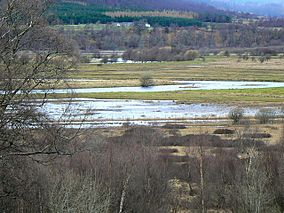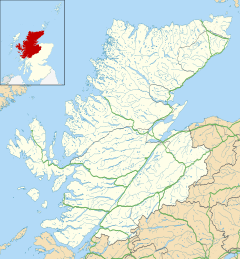Insh Marshes facts for kids
Quick facts for kids Insh Marshes National Nature Reserve |
|
|---|---|
|
IUCN Category IV (Habitat/Species Management Area)
|
|
 |
|
| Location | Badenoch and Strathspey, Highland, Scotland |
| Area | 695 ha (1,720 acres) |
| Designation | NatureScot |
| Established | 2003 |
| Owner | Royal Society for the Protection of Birds (RSPB) |
| Insh Marshes NNR | |
| Official name: River Spey - Insh Marshes | |
| Designated: | 2 February 1997 |
| Reference #: | 889 |
The Insh Marshes are a very special natural area in Scotland. They are found along the River Spey between the towns of Kingussie and Kincraig. This area is in Badenoch and Strathspey, which is part of the Highland region.
Many people say that the Insh Marshes are one of the most important wetlands in all of Europe! A wetland is a place where the land is covered by water, like a marsh or swamp. The marshes are about 220 to 240 meters above sea level. They form one of the biggest areas of "floodplain mire" and "fen" plants in Scotland. These are types of wetlands with special plants.
The Insh Marshes cover about 11 square kilometers. A large part of this area, about 7 square kilometers, is owned and looked after by the Royal Society for the Protection of Birds (RSPB). This part is a national nature reserve. The RSPB has made walking trails and built two bird hides. These hides let visitors watch the birds and enjoy the beautiful nature without disturbing the wildlife.
Contents
Amazing Plants and Animals at Insh Marshes
The Insh Marshes are home to many different kinds of plants and animals. It's a very important place for nature.
Unique Plants of the Marshes
The marshes have many sedge plants. These are grass-like plants that grow in wet areas. Two special types found here are string sedge and water sedge. The string sedge is very rare in Britain. Insh Marshes is one of only two places in the whole country where it grows!
Other interesting flowering plants also grow here. These include the least water-lily, awlwort, cowbane, and shady horsetail.
Rare Insects and Other Small Creatures
The Insh Marshes are a great place to find rare wetland invertebrates. Invertebrates are animals without a backbone, like insects. Many types of flies, beetles, and moths live here.
One very special find is the spider Wabasso replicatus. Insh Marshes is the only place in Britain where this spider has been found! Other notable invertebrates include:
- The aquatic beetle Donacia aquatica
- The fly Tipula marginella
- The horse-fly Hybomitra lurida
- The snipe-fly Thereva inornata
The birch woodlands above the marshes are also home to several moth species. These include the Rannoch sprawler and cousin german.
In 2014, a new insect species for Scotland was found here. It was a type of caddisfly called Molanna angustata. Before this, it was only known in Wales and England. A trainee ecologist from RSPB Scotland found two males in a moth trap near Kingussie. This showed how special the marshes are for discovering new species!
Fish and Mammals in the Area
The Arctic charr is a type of fish that spawns, or lays its eggs, along the River Spey and its smaller streams. The Insh Marshes also provide a perfect home for otters. Otters are playful mammals that love to live near water.
Amazing Birds of Insh Marshes
The Insh Marshes are most famous for the many different kinds of birds that come here. Lots of birds breed, or have their babies, here every summer.
Some of the birds that breed at Insh Marshes include:
- Ospreys (large birds of prey that catch fish)
- Ducks like the Eurasian wigeon, shoveler, and goldeneye
- Waders, which are birds that wade in shallow water, such as the redshank, snipe, curlew, and lapwing
The marshes also get visitors in the winter. Large groups of greylag geese fly here all the way from Iceland. Up to 200 whooper swans also come to the marshes for the colder months.
Why Insh Marshes Are Protected
The Insh Marshes are so important that they have many special protections. These protections help keep the area safe for all the plants and animals that live there.
Besides being a national nature reserve (NNR), the marshes have other important titles:
- Site of Special Scientific Interest (SSSI): The marshes and a part of the River Spey are called the "River Spey - Insh Marshes" SSSI. This means they are very important for their plants, animals, or geology.
- Special Protection Area (SPA): This designation protects the area for its birds.
- Special Area of Conservation (SAC): This protects the area for its habitats and species, as part of the Natura 2000 program across Europe.
- Ramsar Convention Site: This is an international agreement that protects important wetlands around the world. Insh Marshes is listed under this convention.
The Insh Marshes national nature reserve is also classified as a Category IV protected area by the International Union for Conservation of Nature (IUCN). This means it's an area managed mainly for protecting specific habitats and species.
See also
 In Spanish: Pantanos de Insh para niños
In Spanish: Pantanos de Insh para niños


